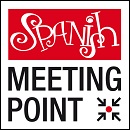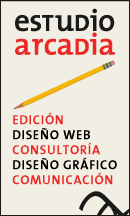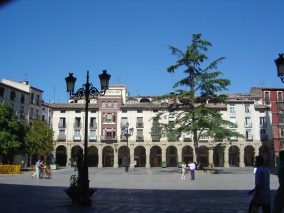Spanish schools and accommodation to study Spanish in Spain
Recent posts
Last schools
introduced
introduced
0 Accommodation

1 Spanish schools

Learning Spanish in Logrono. The tourist guide to study your Spanish course.
General Information. 152,000 inhabitants. 336 kilometres to the north of Madrid. Logroño is the capital of the Autonomous Community of La Rioja, one of the most important grape and wine-growing regions in Spain. After being devastated in 1092 by El Cid, it was rebuilt three years later by Alfonso VI of León and Castile. The Camino de Santiago -the famous pilgrimage route of St. James- passes through Logroño, which is situated on the Ebro River and boasts an old quarter with a rich historical heritage. Besides the University of La Rioja, which offers 26 degree subjects and caters for some 7,500 students, there is also the on-line International University of La Rioja. Logroño is a very attractive place to study Spanish with many language schools offering a wide range of courses.
Surrounding Areas. Parque de La Grajera (4 kilometres) comprises a 55 hectare nature reserve and a 32 hectare reservoir, the most important wetland area in La Rioja, as well as a five-kilometre-long greenway which links it to the city and forms part of the Camino de Santiago. On the northern edge of Logroño, the remains of the first settlement in this area (2nd-3rd century BC) can be seen at the top of Mount Cantabria. The Yuso and Suso monasteries (40 kilometres), both declared World Heritage Sites in 1997 for historical, artistic, religious, linguistic and literary reasons, and also known as Monasterio de San Millán de la Cogolla. Nájera (30 kilometres), whose Monasterio de Santa María la Real is a National Monument. Valdezcaray (75 kilometres), a popular ski resort during the winter months. This wine-producing region is home to numerous bodegas, many of which are open to visitors. The nearest cities are Vitoria (60 kilometres) and Pamplona (85 kilometres).
Main Sights. The Concatedral de Santa María de la Redonda, a co-cathedral built on the site of a 12th century temple; the Convento de la Merced, a former monastery which currently serves as the Parliament of La Rioja and also houses a library and an exhibition hall; two chapels dating from the 17th century: Ermita de San Gregorio and Ermita del Cristo del Humilladero; the neo-Baroque Post Office Building (Edificio de Correos); the Revellín Wall (Muralla del Revellín); the Stone Bridge (Puente de Piedra), built in 1884; the 330-metre-long Iron Bridge (Puente de Hierro); the Puente de Mantible, an ancient Roman bridge; the Roman remains of Varea; and the pre-Roman and medieval remains on Mount Cantabria. Many of Logroño's avenues, squares and parks are ideal for a relaxing stroll, such as Paseo del Espolón, Paseo del Príncipe de Vergara, Plaza del Ayuntamiento, Plaza del Mercado, Parque del Carmen and Parque del Ebro. The monuments are a major attraction for the many students who decide to study Spanish in Logroño.
Culture. Festival Actual (January), focusing on live music, cinema and other cultural activities. The most interesting museums in Logroño are the Museum of La Rioja, located in the former palatial home of General Espartero; a science museum called Casa de las Ciencias; and the Museo Würth La Rioja, devoted to contemporary art. La Merced is Logroño's main exhibition venue, and the Teatro Bretón (1880) offers a varied programme of plays and musicals.
Shopping. The busiest shopping areas are: "El Paseo de las Cien Tiendas" a pedestrianized ‘Parade of One Hundred Shops', the old quarter, Gran Vía and Calle San Antón. Logroño also has two shopping centres: Parque Rioja and Berceo.
Gastronomy. For a tapas and Rioja wine crawl, you should head for the small side streets off the Paseo del Espolón, especially Calle Laurel and Calle San Juan, popularly known as the ‘trail of the elephants' (senda de los elefantes). La Rioja is rich in local produce; its designation of origin wines are internationally famous, although olive oil, Cameros cheese, Rincón de Soto pears and all kinds of vegetables, such as cauliflowers from Calahorra, asparagus and red peppers are also highly prized. Some of the most typical dishes are: patatas a la riojana (potato and chorizo sausage stew), chuletillas al sarmiento (lamp chops grilled over vine shoots), menestra de verduras (braised mixed vegetables) and bacalao a la riojana (cod in tomato and red pepper sauce).
Sports. In Logroño you can play or learn almost any sport. There are numerous sports facilities, including the 16,000 capacity Estadio Las Gaunas, the home of Logroñés, the city's most important football team. Another major sporting venue is the Palacio de los Deportes de La Rioja, an indoor arena which holds up to 4,000 people. There is a golf course in Parque de La Grajera (4 kilometres), and the Valdezcaray ski resort is 75 kilometres away.
Fiestas. The most important festivities in Logroño are the Fiestas de San Bernabé (11th June), commemorating Logroño's resistance and victory against French invaders in 1521, and the Fiesta de San Mateo (end of September), also known as the Harvest Festival (Fiesta de la Vendimia).
Transport. Logroño is linked to Zaragoza, Vitoria and Pamplona by motorway, and there is also a railway line which runs parallel to the Ebro River. A small airport (14 kilometres to the east) links Logroño with Madrid. It is easy to get from Logroño to other Spanish cities by train or by using the various coach services.
Nightlife. Students who decide to study Spanish in Logroño will discover a very active nightlife. Calle Marqués de San Nicolás and Plaza Martínez Zaporta are the areas where most people congregate for a night out. Equally popular are the pavement cafés, bars and pubs in Portales and Plaza de Mercado, and there is also another area known as La Zona, between Gran Vía and Calle Vitoria.
Surrounding Areas. Parque de La Grajera (4 kilometres) comprises a 55 hectare nature reserve and a 32 hectare reservoir, the most important wetland area in La Rioja, as well as a five-kilometre-long greenway which links it to the city and forms part of the Camino de Santiago. On the northern edge of Logroño, the remains of the first settlement in this area (2nd-3rd century BC) can be seen at the top of Mount Cantabria. The Yuso and Suso monasteries (40 kilometres), both declared World Heritage Sites in 1997 for historical, artistic, religious, linguistic and literary reasons, and also known as Monasterio de San Millán de la Cogolla. Nájera (30 kilometres), whose Monasterio de Santa María la Real is a National Monument. Valdezcaray (75 kilometres), a popular ski resort during the winter months. This wine-producing region is home to numerous bodegas, many of which are open to visitors. The nearest cities are Vitoria (60 kilometres) and Pamplona (85 kilometres).
Main Sights. The Concatedral de Santa María de la Redonda, a co-cathedral built on the site of a 12th century temple; the Convento de la Merced, a former monastery which currently serves as the Parliament of La Rioja and also houses a library and an exhibition hall; two chapels dating from the 17th century: Ermita de San Gregorio and Ermita del Cristo del Humilladero; the neo-Baroque Post Office Building (Edificio de Correos); the Revellín Wall (Muralla del Revellín); the Stone Bridge (Puente de Piedra), built in 1884; the 330-metre-long Iron Bridge (Puente de Hierro); the Puente de Mantible, an ancient Roman bridge; the Roman remains of Varea; and the pre-Roman and medieval remains on Mount Cantabria. Many of Logroño's avenues, squares and parks are ideal for a relaxing stroll, such as Paseo del Espolón, Paseo del Príncipe de Vergara, Plaza del Ayuntamiento, Plaza del Mercado, Parque del Carmen and Parque del Ebro. The monuments are a major attraction for the many students who decide to study Spanish in Logroño.
Culture. Festival Actual (January), focusing on live music, cinema and other cultural activities. The most interesting museums in Logroño are the Museum of La Rioja, located in the former palatial home of General Espartero; a science museum called Casa de las Ciencias; and the Museo Würth La Rioja, devoted to contemporary art. La Merced is Logroño's main exhibition venue, and the Teatro Bretón (1880) offers a varied programme of plays and musicals.
Shopping. The busiest shopping areas are: "El Paseo de las Cien Tiendas" a pedestrianized ‘Parade of One Hundred Shops', the old quarter, Gran Vía and Calle San Antón. Logroño also has two shopping centres: Parque Rioja and Berceo.
Gastronomy. For a tapas and Rioja wine crawl, you should head for the small side streets off the Paseo del Espolón, especially Calle Laurel and Calle San Juan, popularly known as the ‘trail of the elephants' (senda de los elefantes). La Rioja is rich in local produce; its designation of origin wines are internationally famous, although olive oil, Cameros cheese, Rincón de Soto pears and all kinds of vegetables, such as cauliflowers from Calahorra, asparagus and red peppers are also highly prized. Some of the most typical dishes are: patatas a la riojana (potato and chorizo sausage stew), chuletillas al sarmiento (lamp chops grilled over vine shoots), menestra de verduras (braised mixed vegetables) and bacalao a la riojana (cod in tomato and red pepper sauce).
Sports. In Logroño you can play or learn almost any sport. There are numerous sports facilities, including the 16,000 capacity Estadio Las Gaunas, the home of Logroñés, the city's most important football team. Another major sporting venue is the Palacio de los Deportes de La Rioja, an indoor arena which holds up to 4,000 people. There is a golf course in Parque de La Grajera (4 kilometres), and the Valdezcaray ski resort is 75 kilometres away.
Fiestas. The most important festivities in Logroño are the Fiestas de San Bernabé (11th June), commemorating Logroño's resistance and victory against French invaders in 1521, and the Fiesta de San Mateo (end of September), also known as the Harvest Festival (Fiesta de la Vendimia).
Transport. Logroño is linked to Zaragoza, Vitoria and Pamplona by motorway, and there is also a railway line which runs parallel to the Ebro River. A small airport (14 kilometres to the east) links Logroño with Madrid. It is easy to get from Logroño to other Spanish cities by train or by using the various coach services.
Nightlife. Students who decide to study Spanish in Logroño will discover a very active nightlife. Calle Marqués de San Nicolás and Plaza Martínez Zaporta are the areas where most people congregate for a night out. Equally popular are the pavement cafés, bars and pubs in Portales and Plaza de Mercado, and there is also another area known as La Zona, between Gran Vía and Calle Vitoria.
© TEXT: SPANISH IN TOUR.
VIDEO: Fundación Logroño Turismo
VIDEO: Fundación Logroño Turismo























